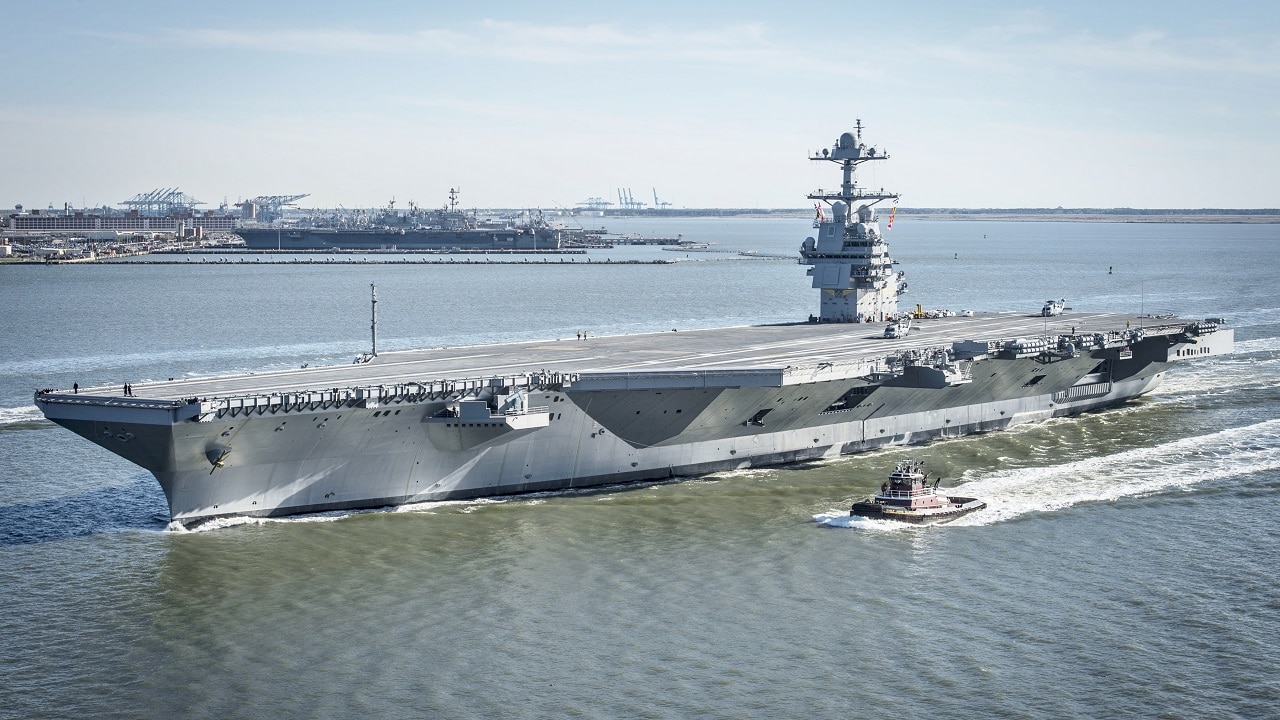The crew of the U.S. Navy’s largest warship has been spending a few days in Trieste, Italy, after sailing up the Adriatic, the service announced on Tuesday. The USS Gerald R. Ford (CVN-78), embarked staff from Carrier Strike Group (CSG) 12, and Arleigh Burke-class guided-missile destroyer USS Ramage (DDG 61) arrived in the port on Saturday.
It was the supercarrier’s fifth stop while deployed to the U.S. Naval Forces Europe (NAVEUR) area of operations, and it provided an opportunity to enhance the strong partnership between the U.S. and Italy.
CVN-78 has been anchored off the coast of Trieste and during its port-of-call visit it has been hosting local officials and military leaders for a lunch and tour to celebrate the strong, extensive alliance between the U.S. and Italy. The port call further provided Gerald R. Ford sailors an opportunity to experience Italy’s and the Friuli-Venezia Giulia region’s rich history and culture.
“This visit is a great opportunity for the Sailors of USS Gerald R. Ford, Carrier Strike Group 12, Carrier Air Wing 8, and Destroyer Squadron 2 to engage with a key ally on a personal level and experience Italian culture,” said Gerald R. Ford Commanding Officer Capt. Rick Burgess. “Our crew is excited to engage with the local community and give back to the city hosting us by participating in a city clean-up event.”
Ford’s Crew Has Been Busy
The visit to the Italian port city was likely welcomed by the crew, which has had quite a packed deployment. In just the past four months the Gerald R. Ford Strike Group has executed numerous bilateral exercises and training events with the Italian Navy to enhance and demonstrate the U.S. commitment to security in the Mediterranean.
In addition, the navies of the NATO allies have conducted personnel transfers to learn from one another and increase operational interoperability and understanding. Before arriving in the Italian city, the largest and newest nuclear-powered carrier also hosted key military leaders aboard to observe the first-in-class warship’s operations at sea.
Guests experienced firsthand the USS Gerald R. Ford’s capabilities, including witnessing the launch and recovery of embarked Carrier Air Wing (CVW) 8 aircraft from the flight deck, touring the carrier’s aircraft maintenance repair facilities, and meeting with GRFCSG Sailors and leadership.
“The Gerald R. Ford Carrier Strike Group has operated with our Italian partners throughout our time in the Mediterranean,” said Rear Adm. Erik J. Eslich, Commander, Carrier Strike Group 12. “The interoperability between our forces continues to improve our understanding of our collective capabilities and fosters stability and security in the region.”
USS Gerald R. Ford deployed with the rest of the strike group in May for its first worldwide deployment. While in European Waters, the nuclear-powered supercarrier first made a port call in Oslo, Norway. It went under NATO command while sailing in the Arctic Circle.
It spent much of the summer in the much warmer waters of the Mediterranean, and in July made a scheduled port visit to the Greek capital of Athens.
Lead Vessel of a New Class of Supercarriers
The $13 billion USS Gerald R. Ford is the lead vessel in a new class of ten planned flattops. Larger in size than the preceding Nimitz-class carriers, CVN-78 can operate with a smaller crew thanks to a greater emphasis on automation. The warship will also see a reduction in maintenance requirements, as well as a crew workload reduction.
That is meant to allow for improved quality of life for the crew including better berthing compartments, larger gyms and workout facilities, and even more ergonomic workspaces. Yet, the carrier’s basic mission will remain largely unchanged.
The flattop will be capable of carrying upwards of 90 of the United States Navy’s most advanced aircraft, and that will include the F-35C Lightning II Joint Strike Fighter, F/A-18E/F Super Hornet, E-2D Advanced Hawkeye, EA-18G Growler electronic attack aircraft and MH-60R/S helicopter as well as unmanned air and combat vehicles. In addition, Ford will also be able to recover and launch various Short Take-Off and Vertical Landing (STOVL) aircraft flown by the United States Marine Corps including the F-35B Lightning II.
The Gerald R. Ford Carrier Strike Group consists of Carrier Strike Group 12, Carrier Air Wing 8, Destroyer Squadron 2, USS Normandy (CG 60), USS Ramage (DDG 61), USS McFaul (DDG 74), and USS Thomas Hudner (DDG 116).
Author Experience and Expertise
A Senior Editor for 19FortyFive, Peter Suciu is a Michigan-based writer. He has contributed to more than four dozen magazines, newspapers, and websites with over 3,200 published pieces over a twenty-year career in journalism. He regularly writes about military hardware, firearms history, cybersecurity, politics, and international affairs. Peter is also a Contributing Writer for Forbes and Clearance Jobs. You can follow him on Twitter: @PeterSuciu.

